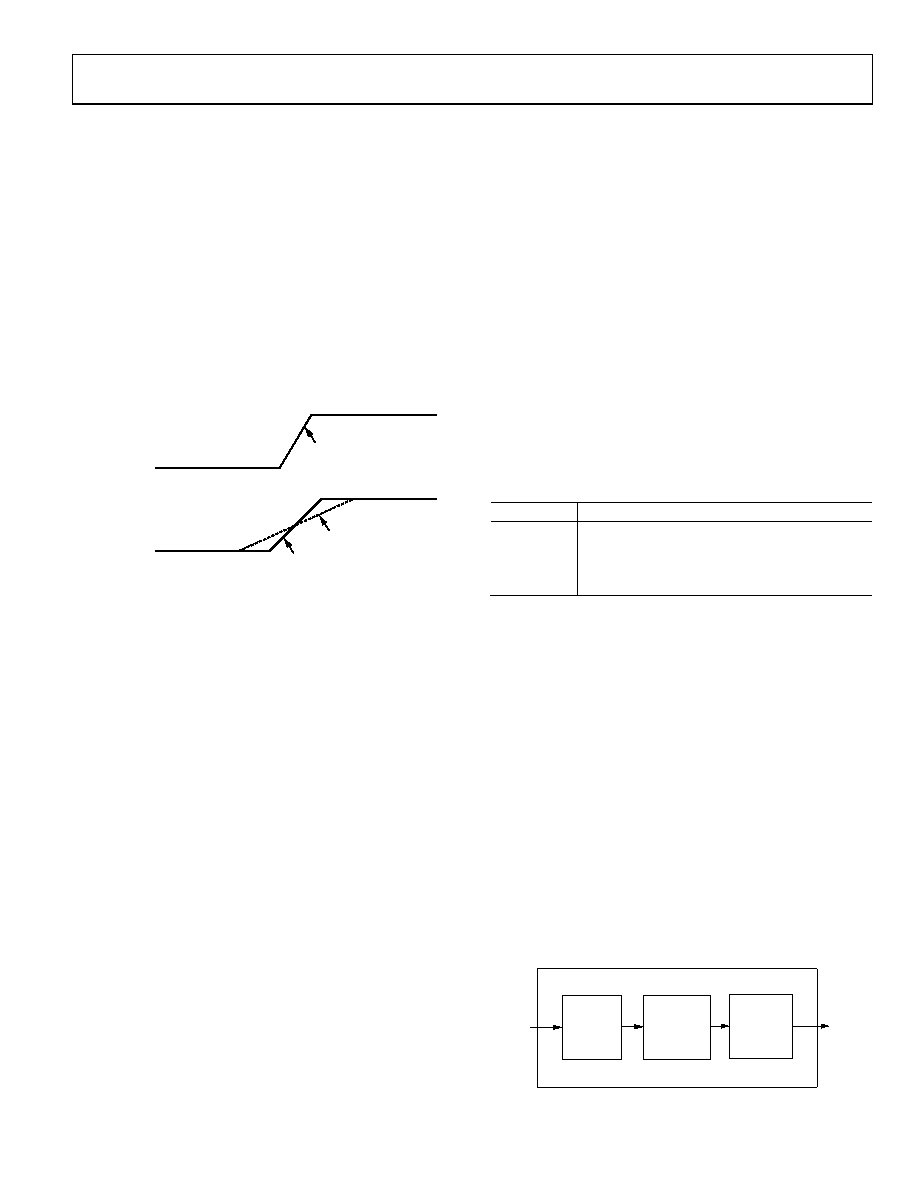参数资料
| 型号: | ADV7184BSTZ |
| 厂商: | Analog Devices Inc |
| 文件页数: | 46/112页 |
| 文件大小: | 0K |
| 描述: | IC DECODER VID SDTV MULTI 80LQFP |
| 标准包装: | 1 |
| 类型: | 视频解码器 |
| 应用: | 投影仪,录音机,安全 |
| 电压 - 电源,模拟: | 3.15 V ~ 3.45 V |
| 电压 - 电源,数字: | 1.65 V ~ 2 V |
| 安装类型: | 表面贴装 |
| 封装/外壳: | 80-LQFP |
| 供应商设备封装: | 80-LQFP(14x14) |
| 包装: | 托盘 |
第1页第2页第3页第4页第5页第6页第7页第8页第9页第10页第11页第12页第13页第14页第15页第16页第17页第18页第19页第20页第21页第22页第23页第24页第25页第26页第27页第28页第29页第30页第31页第32页第33页第34页第35页第36页第37页第38页第39页第40页第41页第42页第43页第44页第45页当前第46页第47页第48页第49页第50页第51页第52页第53页第54页第55页第56页第57页第58页第59页第60页第61页第62页第63页第64页第65页第66页第67页第68页第69页第70页第71页第72页第73页第74页第75页第76页第77页第78页第79页第80页第81页第82页第83页第84页第85页第86页第87页第88页第89页第90页第91页第92页第93页第94页第95页第96页第97页第98页第99页第100页第101页第102页第103页第104页第105页第106页第107页第108页第109页第110页第111页第112页

ADV7184
Rev. A | Page 39 of 112
CHROMA TRANSIENT IMPROVEMENT (CTI)
The signal bandwidth allocated for chroma is typically much
smaller than that of luminance. With older devices, this was a
valid way to fit a color video signal into a given overall band-
width because the human eye is less sensitive to chrominance
than to luminance.
The uneven bandwidth, however, may lead to visual artifacts
during sharp color transitions. At the border of two bars of
color, both components (luma and chroma) change at the same
time (see Figure 22).
Due to the higher bandwidth, the signal transition of the luma
component is usually much sharper than that of the chroma
component. The color edge is not sharp and can be blurred, in
the worst case, over several pixels.
05
47
9
-02
2
LUMA
SIGNAL
DEMODULATED
CHROMA
SIGNAL
LUMA SIGNAL WITH A
TRANSITION, ACCOMPANIED
BY A CHROMA TRANSITION
ORIGINAL SLOW CHROMA
TRANSITION PRIOR TO CTI
SHARPENED CHROMA
TRANSITION AT THE
OUTPUT OF CTI
Figure 22. CTI Luma/Chroma Transition
To correct for such uneven bandwidths, the CTI block examines
the input video data. It detects transitions of chroma and can be
programmed to create steeper chroma edges in an attempt to
artificially restore lost color bandwidth. By operating only on
edges that are greater than a certain threshold, the CTI block
ensures that noise is not emphasized. Care has also been taken to
avoid edge ringing and undesirable saturation and hue distortion.
Chroma transient improvements are needed primarily for signals
that have severe chroma bandwidth limitations. For these types
of signals, it is strongly recommended to enable the CTI block
via CTI_EN.
CTI_EN, Chroma Transient Improvement Enable,
Address 0x4D [0]
0—Disables the CTI block.
1 (default)—Enables the CTI block.
CTI_AB_EN, Chroma Transient Improvement
Alpha Blend Enable, Address 0x4D [1]
This bit enables an alpha-blend function, which mixes the
transient improved chroma with the original signal. The
sharpness of the alpha blending can be configured via the
CTI_AB [1:0] bits. For the alpha blender to be active, the CTI
block must be enabled via the CTI_EN bit. The settings of the
CTI_AB_EN bit are as follows:
0—Disables the CTI alpha blender.
1 (default)—Enables the CTI alpha blender.
CTI_AB [1:0], Chroma Transient Improvement Alpha
Blend, Address 0x4D [3:2]
The CTI_AB [1:0] controls the behavior of alpha-blend
circuitry, which mixes the sharpened chroma signal with the
original one. It thereby controls the visual impact of CTI on the
output data.
For CTI_AB [1:0] to become active, the CTI block must be
enabled via the CTI_EN bit and the alpha blender must be
switched on via CTI_AB_EN.
Sharp blending maximizes the effect of CTI on the picture, but
may also increase the visual impact of small amplitude, high
frequency chroma noise.
Table 49. CTI_AB [1:0] Function
CTI_AB [1:0]
Description
00
Sharpest mixing
01
Sharp mixing
10
Smooth mixing
11 (default)
Smoothest mixing
CTI_C_TH [7:0], CTI Chroma Threshold,
Address 0x4E [7:0]
The CTI_C_TH [7:0] value is an unsigned, 8-bit number speci-
fying how big the amplitude step in a chroma transition must be
to be steepened by the CTI block. Programming a small value
into this register causes even, small edges to be steepened by the
CTI block. Making CTI_C_TH [7:0] a large value causes the
block to only improve large transitions.
The default value for CTI_C_TH [7:0] is 0x08, indicating the
threshold for the chroma edges prior to CTI.
DIGITAL NOISE REDUCTION (DNR) AND
LUMA PEAKING FILTER
DNR is based on the assumption that high frequency signals with
low amplitude are probably noise and that their removal, therefore,
improves picture quality. There are two DNR blocks in the
ADV7184: the DNR1 block before the luma peaking filter and the
DNR2 block after the luma peaking filter, as shown in Figure 23.
LUMA
OUTPUT
DNR1
LUMA PEAKING
FILTER
DNR2
LUMA
SIGNAL
05479-
023
Figure 23. DNR and Peaking Block Diagram
相关PDF资料 |
PDF描述 |
|---|---|
| ADV7188BSTZ | IC DECODER VID MULTIFORM 80LQFP |
| ADV7189BBSTZ | IC VIDEO DECODER SDTV 80-LQFP |
| ADV7194KSTZ | IC ENCODER VIDEO EXT-10 80-LQFP |
| ADV7202KSTZ | IC CODEC VIDEO 10BIT 64LQFP |
| ADV7311KST | IC VID ENC 6-12BIT DAC'S 64LQFP |
相关代理商/技术参数 |
参数描述 |
|---|---|
| ADV7185 | 制造商:AD 制造商全称:Analog Devices 功能描述:Professional NTSC/PAL Video Decoder with 10-Bit CCIR656 Output |
| ADV7185KST | 制造商:AD 制造商全称:Analog Devices 功能描述:Professional NTSC/PAL Video Decoder with 10-Bit CCIR656 Output |
| ADV7186 | 制造商:AD 制造商全称:Analog Devices 功能描述:Video Decoder and Display Processor |
| ADV7186BBCZ | 功能描述:IC VIDEO DECODER 196CSPBGA RoHS:是 类别:集成电路 (IC) >> 线性 - 视频处理 系列:- 产品变化通告:Product Discontinuation 07/Mar/2011 标准包装:3,000 系列:OMNITUNE™ 类型:调谐器 应用:移动电话,手机,视频显示器 安装类型:表面贴装 封装/外壳:65-WFBGA 供应商设备封装:PG-WFSGA-65 包装:带卷 (TR) 其它名称:SP000365064 |
| ADV7186BBCZ-RL | 功能描述:IC VIDEO DECODER 196CSPBGA RoHS:是 类别:集成电路 (IC) >> 线性 - 视频处理 系列:- 产品变化通告:Product Discontinuation 07/Mar/2011 标准包装:3,000 系列:OMNITUNE™ 类型:调谐器 应用:移动电话,手机,视频显示器 安装类型:表面贴装 封装/外壳:65-WFBGA 供应商设备封装:PG-WFSGA-65 包装:带卷 (TR) 其它名称:SP000365064 |
发布紧急采购,3分钟左右您将得到回复。